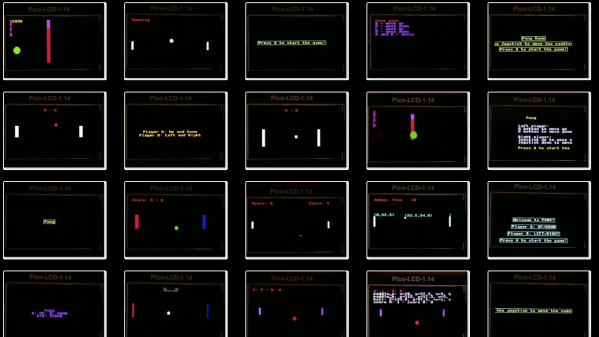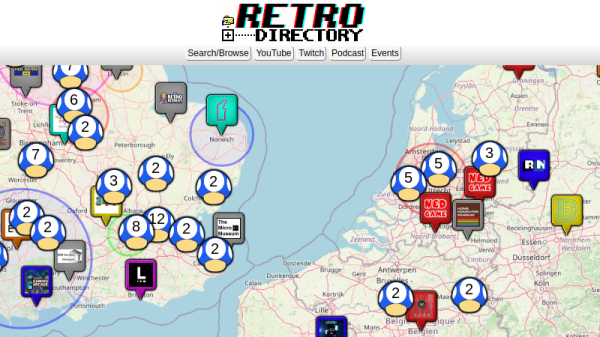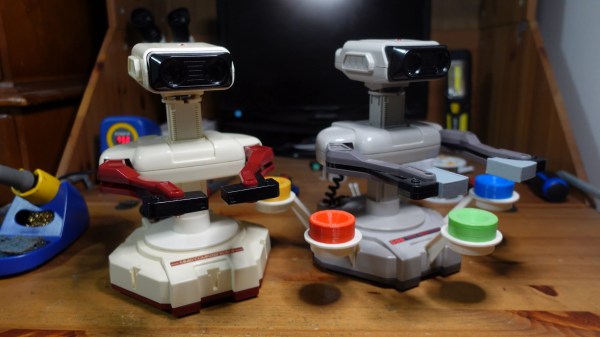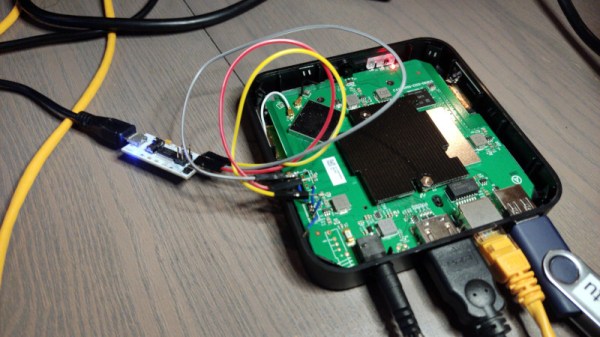In a very real way, Pong started the video game revolution. You wouldn’t have thought so at the time, with its simple gameplay, rudimentary controls, some very low-end sounds, and a cannibalized TV for a display, but the legendarily stuffed coinboxes tell the tale. Fast forward 50 years or so, and Pong has been largely reduced to a programmer’s exercise to see how few lines of code can stand in for what [Ted Dabney] and [Allan Alcorn] accomplished. But now even that’s too much, as OpenAI Codex can generate a playable Pong from just a few prompts, at least most of the time. Continue reading “Let Machine Learning Code An Infinite Variety Of Pong Games”
Travel The World Looking For Retro Tech, Virtually
For those who have a passion for vintage hardware, whether it be a classic computer or a war-surplus ham radio rig, finding the things without resorting to paying shipping fees on eBay can sometimes be tricky. Your best bet is to find a local fair or swap event, but it always seems they’re the kind of thing you find out about the weekend after they were held.
Looking to make these sort of events more visible and easier to keep track of, [RobSmithDev] has created the Retro.Directory. Scrolling your way across the globe you can see markers that indicate places of interest for the retro aficionado, such as museums, repair shops, and old school arcades, as well as upcoming events. Continue reading “Travel The World Looking For Retro Tech, Virtually”
Hackaday Podcast 206: Busted Crypto Killed The Queen, Kicad’s New Clothes, Peer Inside The Sol 20
Under the weather though they both were, Editor-in-Chief Elliot Williams and Staff Writer Dan Maloney got together to take a look under the covers of this week’s best and brightest hacks. It was a banner week, with a look at the changes that KiCad has in store, teaching a CNN how to play “Rock, Paper, Scissors,” and going deep into the weeds on JPEG.
We dipped a toe into history, too, with a look at one of the sexiest early hobbyist computers, seeing how citizen scientists are finding ancient burial mounds, and looking at the cryptography that cost a queen her head. Rather look to the future? We get it — which is why we talked about a greener, cleaner way of making hydrogen from methane, as well as a generatively designed five-axis 3D printer. From laser-precise knife sharpening to circuit simulation with Python to clear plastic TVs of the 1930s, there’s something for everyone!
Download the podcast in case our servers get unlucky.
Check out the links below if you want to follow along, and as always, tell us what you think about this episode in the comments!
Retro Gadgets: Nintendo R.O.B Wanted To Be Your Friend
Too busy playing video games to have a social life? No worries. In 1985, Nintendo introduced R.O.B. — otherwise known as the Robotic Operating Buddy. It was made to play Nintendo with you. In Japan, apparently, it was the Family Computer Robot. We suppose ROB isn’t a very Japanese name. The robot was in response to the video game market crash of 1983 and was meant to keep the new Nintendo Entertainment System (NES) from being classified as a video game, which would have been a death sentence at the time of its release.
Since you might not have heard of R.O.B., you can probably guess it didn’t work out very well. In fact, the whole thing tanked in two years and resulted in only two games.
Continue reading “Retro Gadgets: Nintendo R.O.B Wanted To Be Your Friend”
What’s Old Is New Again: A Linux PC From A Set Top Box
There was a time around two decades ago, when the new hotness was taking control of home routers to use as small Linux computers. An echo of this era lives on in the name of the OpenWrt minimal Linux distribution, in reference to the Linksys WRT54G router which started it all. Routers as small computers were displaced by small cheap Linux machines from the likes of Raspberry Pi, and the promise of discarded home network gear doing interesting stuff receded. Now it might just be back, as [Jasper Devreker] shows us an Android TV set-top box from a mobile carrier repurposed as a Linux computer that can even run a desktop environment.
The method starts as you might expect, by identifying a mystery connector as a debug serial port. This outputs all sorts of interesting boot information, but can be dropped into a uBoot shell. From here with a bit of effort the eMMC storage could be dumped, and from that the nature of the machine could be deduced. The CPU is an Amlogic quad core ARM Cortex-A53 SoC, which by a stroke of luck is a target for which an Armbian build is available. From there a Linux installation could be assembled, and even an AFCE desktop.
These boxes are handed out in the hundreds of thousands by home connectivity providers, so there’s value in this type of hack as they become available for experimenters. Perhaps it’s more useful as a small headless Linux machine than as a desktop, but we sense there are more machines to come in this line.
If you’d like a little bit of history on hackable Linux devices, have a read of one of our earliest posts featuring the Linksys WRT54G.
GhostSCAD: Marrying OpenSCAD And Golang
It’s been at least a couple of months since we’ve seen a different 3D modeling language project, so here’s [Lukasz Janyst] with GhostSCAD: a take on creating OpenSCAD models, using the Go language as the front end, bringing all the delights this modern modular language has to offer (and a few of its own idiosyncrasies.) As [Lukasz] says in the blog, from a programmer’s viewpoint, openSCAD has a number of failings that make it not necessarily hard, just kinda annoying to work with, due to the way the geometry tree works. The OpenSCAD way of working ends up with the programmer requiring knowledge of the internal workings of sub-modules, in order to work at the top level (assembly) which is not an ideal situation from a code reuse perspective.
A programmer would describe this problem as “abstraction leakage” and it doesn’t make modular, reusable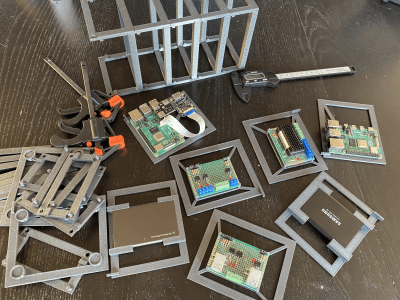 coding easy to do without a lot of extra work. [Lukasz] says regarding the example GhostSCAD project, that some parts were modeled in a way that knowledge was needed of some mounting points of sub-modules, but those sub-modules had no way to expose this information to the outside world. GhostSCAD enables the programmer to define parts that expose specific parameters to the world that can be queried, for example, to produce a joining part, or an exploded assembly diagram. These properties can be interpreted without the querying module having any knowledge of the internal structure of the thing it’s working with. GhostSCAD provides a Java3D-like API for defining the geometry tree, which may be familiar to some.
coding easy to do without a lot of extra work. [Lukasz] says regarding the example GhostSCAD project, that some parts were modeled in a way that knowledge was needed of some mounting points of sub-modules, but those sub-modules had no way to expose this information to the outside world. GhostSCAD enables the programmer to define parts that expose specific parameters to the world that can be queried, for example, to produce a joining part, or an exploded assembly diagram. These properties can be interpreted without the querying module having any knowledge of the internal structure of the thing it’s working with. GhostSCAD provides a Java3D-like API for defining the geometry tree, which may be familiar to some.
Directing Ambient Light For Some Extra Glow
[Yuichiro Morimoto] wanted to create a decorative lamp, one that wasn’t burdened with batteries or wires, but used just the ambient light in the room to create a directed glow effect. Using a coloured circular acrylic sheet, with a special coating (not specified) ambient light impinging on the surface is diffused toward the edge. This centre sheet is embedded in an opalescent sheet, which scatters the light from the center sheet, giving a pleasant glow, kind of akin to a solar corona. An additional diffuser cover sheet on the front covers over the edge to hide it, and further enhance the glow effect.
Details of the ‘special coating’ are scarce, with the coloured sheet described as a condenser plate. This clearly isn’t the same as diffuser plastic, as that cannot be seen through as clearly as some of the photographs show. So we’re a little stumped on this one! Please answer in the comments if you can, ahem, shed some light on this one!
When talking about ambient light, many people will think more along the lines of active lighting, for example, adaptive ambient light around a TV like this hack.
Continue reading “Directing Ambient Light For Some Extra Glow”

